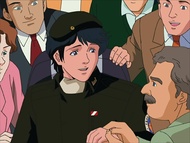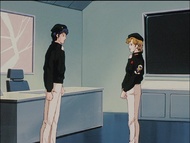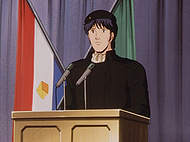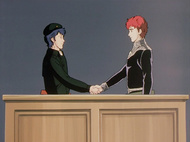Yang Wen-li
From Gineipaedia, the Legend of Galactic Heroes wiki
 Admiral Yang Wen-li (798 UC (489 IC / 3598 CE)) | |
| Gender: | Male |
| Affiliation: | El Facil Revolutionary Government Free Planets Alliance (former) |
| Rank: | Fleet Admiral |
| Flagship(s): | Ulysses Leda II (former) Hyperion (former) |
| Status: | Deceased (assassination) |
| Born: | 4 April 767 UC (458 IC / 3567 CE) |
| Died: | 1 June 800 UC (2 NIC / 491 IC / 3600 CE) |
| Father: | Yang Tai-long |
| Spouse(s): | Frederica Greenhill |
| Played by: | Tomiyama Kei (Deceased) (MCISS, OVA) Gōda Hozumi (HBSHBL, SL, TBT) Hara Yasuyoshi (GW) Suzumura Kenichi (DNT) |
Yang Wen-li (Japanese: ヤン・ウェンリー) was an officer in the Free Planets Star Fleet. Known as one of the greatest admirals in human history, and at the very least equal to the brilliance of his Imperial counterpart Reinhard von Lohengramm. Despite his genius, Yang Wen-li was a relatively simple man harbouring no great ambitions. A firm believer in democracy, Yang Wen-li followed his ideals without wavering throughout his entire life.
Contents |
Early life

Yang Wen-li was born in 767 UC (458 IC / 3567 CE) to a civilian merchant family. He was raised largely by his father, Yang Tai-long, as his mother died when he was just five years old. Yang spent most of his childhood aboard his father's interstellar trade ship, plying the star lanes between Heinessen and Fezzan.
Education
At the age of 16, Yang Tai-long reluctantly gave his son permission to study history. His father soon passed away after an accident, leaving his ship and heavily mortgaged shipping company to be repossessed by lenders, and it was discovered that his father's artwork collection consisted of entirely of fakes. Yang Wen-li was left penniless and was unable to attend Heinessen Memorial University as he had originally planned. He thus enrolled himself in a military academy in order to further his education.
Yang studied in the War History Studies Department of the Free Planets Alliance Officer Academy with the intention of becoming a historian; his tuition fees would be waived, however, on the condition that he enter into military service upon graduation. He received training as a pilot, but proved ineffective. By his own reckoning, he only shot down an opponent two or three times while being shot down thirty times in the simulator. While Yang was still in school, however, the War History Studies Department was dissolved, forcing Yang to transfer to the Strategic Studies Department. As a student, Yang described himself as being always on the verge of flunking out. Although this gave him the appearance of an officer of average talent – he graduated right in the middle of the Class of 787 – his grades reflected his lack of interest rather than his academic abilities. (SL: 'The Hero of El Facil', Legend of Galactic Heroes Volume 3: Endurance)
Early military career
El Facil
In 788 UC (479 IC / 3588 CE), Yang Wen-li as a Sub-lieutenant was assigned as a staff officer to Rear Admiral Arthur Lynch on El Facil, a Free Planets Alliance planet located outside the Iserlohn Corridor. When the Imperial Fleet invaded El Facil, the Alliance fleet fled the planet, leaving behind the civilian population. Yang remained on the planet and successfully directed the evacuation of over three million civilians, a feat which earned him widespread popularity throughout the Alliance and the title "Hero of El Facil." (SL: 'The Hero of El Facil', 'The Hero's New Assignment')
While on El Facil, Yang first encountered a young Frederica Greenhill while choking on some food. Frederica offered Yang coffee in a paper cup. After he had drunk the coffee, Yang told her, "I hate coffee. I wish you'd given me tea." Frederica's perfect memory would allow her to recall this comment years later, after she was assigned to the 13th Fleet, prompting Yang to apologise for his rudeness.

Rising in ranks
For his efforts in El Facil, Yang was promoted to Lieutenant on 19 September 788 UC (479 IC / 3588 CE). Six hours after his promotion, he was promoted again to Lt Commander, making it effectively a double promotion. He was then granted an extended leave and would only receive a new appointment on November 788 UC (479 IC / 3588 CE), where he was dispatched to the planet Econia as counsellor (effectively the third-in-command) of a prisoner-of-war camp located in there. (SL: 'The Hero's New Assignment', 'Between the Mourning Dress and Military Uniform')
On Econia, he was caught into a conspiracy involving a prisoner rebellion and his successful handling of the situation resulted in a premature end to his appointment, which lasted only two weeks. Nevertheless, it was during his appointment in Econia where he became acquainted with Fyodor Patrichev and Murai, both of which would become important members of his staff in the future. (SL: 'Prisoners and Hostages', 'A Rebellion of Microscopic Size', 'The Hero of Econia')
On 1 March 789 UC (480 IC / 3589 CE), Yang was appointed as an Operations Staff Officer under the Alliance 8th Fleet. It was during this appointment where he would participate in the Fifth Battle of Iserlohn in 792 UC (483 IC / 3592 CE). (SL: 'The Journey in Search of the Exit', Golden Wings)
By 794 UC (485 IC / 3594 CE), Yang was transferred to the Fleet Headquarters while remaining as an Operations Staff Officer. As a Captain, he participated in the Battle of Van-Fleet and the Sixth Battle of Iserlohn, during which he made several tactical contributions which led him to be promoted to the rank of Commodore, despite the overall debacle in the operation. (HBSHBL: 'The Battle of Van-Fleet Starzone', 'A Hundred Billion Stars, One Ambition')
Over the time of his rise, Yang remained a popular officer whereas the Alliance citizenry was concerned, but was seen as a political troublemaker by many of the military commanders, largely due to his rather passive yet clear admonishments of military policies. One example of this was during the weeks preceding the Third Battle of Tiamat, when military negligence had led to the loss of several merchant ships and that of one cruiser which had remained dedicated to its assigned duties. When asked about his opinion on the matter, Yang noted that the lost crew would have been better off with one more ship rather than posthumous medals. Yang was quickly led away from reporters following this comment. (TBT: 'Part One')
The Battle of Legnica

On 795 UC (486 IC / 3595 CE), Yang was appointed to the Alliance 2nd Fleet under Vice Admiral Paetta as a General Staff Officer. Initially, Vice Admiral Paetta disliked Yang, viewing him as inexperienced and constantly ignored his advice. When the 2nd Fleet was dispatched to the gas giant planet Legnica as part of an expedition to capture the Iserlohn Fortress, it encountered an Imperial fleet led by Reinhard von Lohengramm (then Müsel). After a brief skirmish, a massive electrical storm was created due to the crossfire heating up the primarily helium and hydrogen atmosphere of Legnica, which in turn generated extremely strong winds. Reinhard, having anticipated the strong winds, had pulled his fleet up to the calmer upper atmosphere, whereas Paetta refused to listen to Yang's suggestion to ascend and the 2nd Fleet became caught in the winds, taking some damage as a result.
Yang then realised it was possible for the Imperial forces to wipe out the 2nd Fleet by simply igniting the volatile gases of the Legnica atmosphere, but did not think any of the commanders in the Imperial Fleet had the ingenuity to think of such a plan; despite this, he still advised Paetta to command the fleet to ascend out of the atmosphere, who ignored his suggestion again.
Reinhard fired a single nuclear missile at the planets core, igniting the gasses. Realising the danger, Yang and his friend and colleague Dusty Attemborough acted immediately, forcing their ship to rise up out of the atmosphere, even as a significant portion of the fleet was obliterated by the firestorm. (My Conquest Is the Sea of Stars)
The Fourth Battle of Tiamat
Shortly after the Battle of Legnica, the Alliance forces in the Tiamat Starzone mustered for an assault on Iserlohn Fortress. The Alliance fleets, however, were quickly outmanoeuvred by Reinhard, and was on the verge of annihilation.
Feeling guilty over his inability to convince his superior to evacuate Legnica in time which resulted in the deaths of many fellow soldiers, Yang volunteered to go on a diversionary attack on the Iserlohn Fortress, in order to buy the rest of the fleet time to escape from battle. Yang took the battleship Ulysses with a skeleton crew, and four drone ships, on a roundabout course for the fortress, releasing dummy-drones to make the Imperials think he was leading several thousand Alliance warships into battle.
Reinhard, however, saw through Yang's strategy. With no other choice, Yang brought the Ulysses immediately underneath Reinhard's personal flagship, the Brunhild, effectively taking Reinhard hostage. Yang's assumption that Reinhard being an important figure in his fleet was correct; the Imperial forces would not open fire on the Alliance warships, for fear of losing the life of Reinhard. This allowed the Alliance forces to safely withdraw from battle. After the Alliance forces retreated, Reinhard allowed the Ulysses to safely leave the battlefield as well. (My Conquest Is the Sea of Stars)
The Battle of Astarte
The Battle of Astarte on January 796 UC (487 IC / 3596 CE) marked a turning point in Yang Wen-li's career, which began when the Alliance attacked the newly-appointed Imperial High Admiral Reinhard von Lohengramm's fleet around the Astarte Starzone.
The Alliance fleet was nearly twice the size of the Imperial fleet. Instead of attacking directly, however, the Alliance forces broke apart into three separate fleets, of roughly 13,000 warships each. The Alliance fleets then attempted to encircle Reinhard's fleet of only 20,000 warships, and minimise their losses by attacking the Imperial Fleet from three different angles simultaneously. Yang, who was still serving under Vice Admiral Paetta in the 2nd Fleet, expressed his misgivings over the Alliance strategy, after taking into consideration of Reinhard's genius, whose identity he found out after the Fourth Battle of Tiamat. Although Paetta had by that time recognised Yang's talents, he still refused to take up Yang's battle plans, convinced that the Alliance strategy was infallible.
Reinhard saw through the rather simple strategy immediately, and ordered his fleet to advance toward one of the Alliance fleets before the trap could be implemented. Attacking the a single fleet while the other two were out of range, Reinhard would hold the numerical advantage. He easily annihilated the Alliance's 4th Fleet, under the command of Vice Admiral Pastolle. At this point, Yang, in his capacity as strategic adviser to Vice Admiral Paetta, recommended the 2nd Fleet to immediately move and join up with the 6th Fleet, and then proceed with a concerted attack on the Imperial Fleet. Paetta refused, opting instead to move in to support the besieged 4th Fleet.
By the time Paetta's 2nd Fleet made it to the 4th Fleet, it had been all-but-obliterated, and Reinhard's forces had already begun their assault on the 6th Fleet. The 6th Fleet was completely wiped out as well. Reinhard then attacked the 2nd Fleet. Paetta was severely injured early in the battle, and Yang, being the next highest-ranking officer, assumed command of the 2nd Fleet.
Yang ordered the 2nd Fleet to attack the Imperial forces at their own discretion, and after a brief exchange of fire, Reinhard ordered his fleet to take a spindle formation, and break through the enemy's lines. Yang took advantage of this: while the Imperial Fleet broke through, the Alliance ships pretended to be routed, splitting into two groups which then assaulted the Imperial fleet from behind. Reinhard was then forced to turn to attack, resulting in a massive ring formation between the two fleets — like two snakes devouring each other from their tails. Unwilling to waste time and lives in a pointless battle of attrition, Reinhard retreated from the Astarte Starzone, allowing Yang to do the same.
2,450,000 Imperial soldiers survived the Battle of Astarte. The Alliance survivors numbered 4,060,000. However, the number of Imperial casualties came to only 150,000, while the Alliance had 1,500,000 casualties — ten times as many. Though the Battle of Astarte was an enormous loss for Free Planets Alliance, Yang's successful retreat allowed the Alliance leadership to successfully portray the battle as a "victory", and to name Yang, already the "Hero of El Facil", as the "Hero of Astarte". (LOGH: 'In the Eternal Night', 'The Battle of Astarte')
Miracle Yang
Seizing Iserlohn
Following the Battle of Astarte, Yang's reputation as a hero grew dramatically. At home, however, he became embroiled in the political conflict between the then Secretary of Defence Job Trunicht, backed by his Patriotic Knights Corps, and the War Party. In an attempt to remove Yang from the political picture, he was promoted to the rank of Rear Admiral and given command of the newly-formed 13th Fleet and was ordered to capture Iserlohn Fortress. The 13th Fleet was only half the size of a normal fleet, and it was composed entirely of survivors from the Battle of Astarte and raw recruits. It was fully expected that Yang would throw himself against Iserlohn and perish, as so many others had before. (LOGH: 'Birth of the 13th Fleet')
While making preparations for the assault on Heinessen, Yang became acquainted and was impressed with Walter von Schönkopf and his Rosen Ritter, and was determined to use the Rosen Ritter in his plan to capture Iserlohn Fortress in what would become the Seventh Battle of Iserlohn. On 14 May 796 UC (487 IC / 3596 CE), the Rosen Ritter flew a damaged Imperial cruiser to the fortress, pretending to be wounded Imperial forces. Schönkopf then demanded to see the fortress' commander immediately, claiming to have access to vital intelligence concerning an Alliance invasion of the Iserlohn Corridor. (LOGH: 'The Rosen Ritter')
Yang then drew out the Iserlohn Garrison Fleet, led by Admiral Hans Dietrich von Seeckt, away from the fortress, and advanced toward Iserlohn Fortress while the Iserlohn Fleet was too far away to maintain contact. The 13th Fleet then halted just beyond the range of Iserlohn Fortress' main cannon, the Thor Hammer. The 13th Fleet then began manoeuvring back and forth.
Iserlohn Fortress Commander Admiral Thoma von Stockhausen was confused by the odd movements of Yang's fleet. The Rosen Ritter infiltrators, brought to the fortress command room, indicated that the strange movements were part of the Alliance's plan to seize Iserlohn. The Rosen Ritter were then allowed close to Stockhausen. Schönkopf then tackled the Imperial admiral and held him hostage. Within seconds, the Rosen Ritter infiltrators seized complete control over Iserlohn's command centre. Stockhausen surrendered, and but one of his aides locked down the fortress, forcing the Rosen Ritter to attempt to assault the location of the central computer in order to unlock the fortress to allow the 13th Fleet to dock.

The returning Imperial fleet encountered the 13th Fleet waiting outside the fortress. Seeckt's staff officer, Paul von Oberstein, advised Seeckt to attack the 13th Fleet, correctly determining that Iserlohn was not yet fully under Yang's control. Seeckt, however, ignored Oberstein's advice, and kept the Iserlohn Fleet a safe distance away from Iserlohn to observe the situation. When the Rosen Ritter finally occupied the central computer centre, Yang and the 13th Fleet began docking, leading Seeckt to realise belatedly that Yang had been buying time previously.
Seeckt ordered the Iserlohn Fleet to attack, and Yang used the massive destructive power of the Thor Hammer, destroying more than 1000 Imperial ships with a single shot. Yang then sent a message to Seeckt, requesting that he either surrender or withdraw from battle.
Seeckt responded, saying, "You do not understand a soldier's heart: our code will not allow us to endure living with dishonour. Dying to fulfil our honour, that is our code. For the glory of the Kaiser, all ships will charge to die in an honourable defeat." Seeckt then ordered the Garrison Fleet to advance; Yang Wen-li then specifically targeted Seeckt's flagship, and destroyed it (along with several nearby Imperial ships) with the Thor Hammer. With Seeckt dead, the Garrison Fleet broke away and withdrew, thus ending the Seventh Battle of Iserlohn with victory for the Free Planets Alliance.
Six times before, the Alliance had attempted to capture Iserlohn Fortress from the Empire, and they had failed in all six attempts. Yang managed to take the fortress with the smallest fleet out of the seven total attacks, and managed to do so without a single allied casualty. For this, he became the greatest hero in the Alliance, earning the nicknames "Miracle Yang" and "Yang the Magician." (LOGH: 'Iserlohn Captured!')
Invading the Empire
After his victory at Iserlohn, Yang believed he had finished his duty to the Alliance, and thought that, with Iserlohn firmly in the control of the Alliance, the Alliance would finally possess a strong enough position to negotiate a peace treaty with the Empire and to end the Alliance–Imperial War. When he returned to Heinessen, Yang Wen-li planned to retire from military service with the intention of becoming a historian. However, his superior Fleet Admiral Sidney Sithole rejected his resignation letter and promoted him to the rank of Vice Admiral instead, insisting that the Alliance military was still in dire need for his talents. (LOGH: 'Iserlohn Captured!')
True to Admiral Sithole's expectations (and contrary to Yang's), the Alliance government decided to capitalise on the capture of Iserlohn Fortress and approved a large scale invasion of the Empire, involving eight fleets with a total of over 200,000 ships and 30 million men. During the meeting regarding the invasion, Yang, 5th Fleet Commander Vice Admiral Alexandre Bewcock and 10th Fleet Commander Vice Admiral Ulanhu expressed their doubts over the feasibility of the invasion, but were rebuffed by Commodore Andrew Falk, who was responsible for drafting the invasion plan. In August 796 UC (487 IC / 3596 CE), Yang and the 13th Fleet thus accompanied the other seven fleets to the Iserlohn Fortress, which would serve as the bridgehead for the invasion and command headquarters. (LOGH: 'Invasion of the Imperial Territory')
Initially, the invasion appeared to be proceeding smoothly, with the Alliance expeditionary forces capturing over 200 starzones without resistance. However, this was just part of Reinhard von Lohengramm's scorched earth strategy. Tasked with halting the Alliance invasion, Reinhard decided to withdraw all food supplies from the frontier starzones which would force the Alliance forces to supply the Imperial frontier citizens so as to uphold their image as "liberators". While the Alliance forces were having troubles in maintaining their supply levels within the captured starzones, Reinhard dispatched Siegfried Kircheis to destroy an expected Alliance supply convoy, which succeeded and threw the Alliance forces into a dire situation. (LOGH: 'When the Rain of Grief Comes...', 'Liberation of the Frontier Zone')

Already convinced that the invasion was flawed from the start, Yang decided to request for an order to retreat after learning of the destruction of the supply convoy. Despite being sent with the added recommendations of Vice Admirals Bewcock and Ulanhu, Yang's request for retreat was rejected by Supreme Commander Fleet Admiral Lasalle Lobos on the grounds that the enemy had yet to be engaged with. Yang decided then to prepare for the worst. (LOGH: 'Liberation of the Frontier Zone')
On 10 October 796 UC (487 IC / 3596 CE), Reinhard led a full scale counterattack against the Alliance expeditionary forces. Taken by surprise and coupled with diminishing supplies, most of the Alliance fleets were overwhelmed. The 13th Fleet under Yang managed to evade the Kempff Fleet with minimal losses and successfully left the Jafnhár Starzone which they were stationed in for the Dverger Starzone, where they encountered the even larger Kircheis Fleet. The 13th Fleet again managed to give the Imperial forces the slip and was the only Alliance fleet to remain largely intact when the remaining Alliance forces converged in the Amritsar Starzone for a final showdown. (LOGH: 'The Battle of Amritsar Starzone')
The Battle of Amritsar on 15 October 796 UC (487 IC / 3596 CE) ended with a decisive victory for the Empire, although Yang managed to salvage the situation by using the 13th Fleet to hold the Imperial forces at bay to allow the surviving Alliance ships to retreat, after which he successfully led the 13th Fleet to safety as well. For his efforts in Amritsar, Yang was promoted to the rank of Admiral and he accepted the appointment as the Commander of Iserlohn Fortress with the 13th Fleet being reformed as the Iserlohn Garrison Fleet. (LOGH: 'New Trends')
The Alliance Civil War
In January 797 UC (488 IC / 3597 CE), the Empire offered a prisoner-of-war exchange with the Alliance, ostensibly as a display of magnanimity with the recent ascension of Kaiser Erwin Josef II. It was in fact planned by Reinhard to allow him to secretly plant an agent provocateur in the Alliance to prevent it from interfering with his upcoming power struggle with the high nobles. Yang was suspicious of the Empire's intentions, but relayed the Empire's request to the Alliance government in accordance to protocol, which then accepted the prisoner-of-war exchange without much consideration. While attending the prisoner-of-war returning ceremony in Heinessen, Yang approached Admiral Bewcock, who had by then been appointed as Commander of the Space Fleet for an official directive and confided with him his suspicions of the Empire plotting to stir up unrest within the Alliance. (LOGH: 'Before the Storm')
Yang's suspicions were confirmed when a series of mutinies broke out in several Alliance planets within a short period of days starting on 3 April 797 UC (488 IC / 3597 CE), culminating in a surprise military coup in Heinessen on 13 April. The coup leaders referred to themselves as the National Salvation Military Council (NSMC) and declared their intentions to reform what they saw as a corrupt society with the imposition of martial law and the suspension of the Alliance's democratic institutions. While Yang had expected a coup, he did not expect the leader of the coup to be Admiral Dwight Greenhill, a friend of his and the father of his adjutant Frederica Greenhill. Nevertheless, he was determined to uphold the democratic institutions of the Alliance and made use of the directive he obtained from Admiral Bewcock earlier in the year to deploy the Iserlohn Garrison Fleet on 20 April to suppress the coup d'état. (LOGH: 'The Yang Fleet Goes Out')
Before approaching Heinessen, Yang faced the task of both suppressing the rebellions in the outlying planets and combating the NSMC-aligned 11th Fleet, which was dispatched to stop the Iserlohn Garrison Fleet. Yang assigned Schönkopf to put down the rebellions, who succeeded in taking back the first planet within three days. Meanwhile, he dispatched reconnaissance units to uncover the exact location of the 11th Fleet, before finding and engaging them in the Doria Starzone in May 797 UC (488 IC / 3597 CE). After a brief but brutal battle, the 11th Fleet was annihilated after repeatedly rejecting Yang's offers for their surrender, opening the pathway to Heinessen. Heinessen at that time was protected by a network of battle-satellites known as the Artemis Necklace, the elements of which were designed on similar principles as the Iserlohn Fortress, except on a much smaller scale, and thus was impervious to normal weaponry. Yang however was not particularly concerned over the Artemis Necklace, even claiming that "a war cannot be won by relying on hardware" and was instead more worried that the NSMC would hold the planet's inhabitants as hostages for a last stand. To break down the NSMC completely, physically and psychologically, Yang destroyed the Artemis Necklace by outfitting giant chunks of ice with Bussard ramjets and ramming the Necklace elements at light speed, as well as assigning Commander Baghdash, who was originally dispatched by the NSMC to assassinate Yang but had switched sides after his plans failed, to broadcast a public announcement over Heinessen claiming that the coup was instigated by Reinhard and thus lacked legitimacy and urged the NSMC to surrender. The NSMC crumbled after this series of events and Yang successfully retook Heinessen and ended the Alliance Civil War in August 797 UC (488 IC / 3597 CE). (LOGH: 'The Battle of Doria Starzone, And...', 'Victory for Whose Sake?')
Inquiry and the Eighth Battle of Iserlohn
The Alliance government was restored by Yang after he put an end to the NSMC coup d'état. However, instead of expressing gratitude to him, it began to suspect Yang for harbouring ambitions to overthrow the government and plotted against him. On 9 March 798 UC (489 IC / 3598 CE), under the instigation of High Council Supreme Chairman Job Trunicht, Secretary of Defence Negroponte summoned Yang from the Iserlohn Fortress for an inquiry hearing regarding his actions in the recent civil war. Although the inquiry had no legal basis, Yang acquiesced to the summons and left for Heinessen on board the cruiser Leda II along with his adjutant Lieutenant Frederica Greenhill and escort Ensign Louis Machungo, leaving his friend and colleague Alex Cazerne to serve as acting commander during his absence. An escort of ten destroyers accompanied him to the Iserlohn Corridor's exit point. Yang would not allow a larger force nor would he allow them to go the entirety of the voyage because he was concerned with projecting an intimidating presence. (LOGH: 'One Narrow Thread', 'Lost Things')
Once Yang reached Heinessen, he was separated and isolated from Greenhill and Machungo and was subjected to a series of mind-gruelling inquiry hearings with no clear signs of ending. However, just before Yang could protest with a resignation letter prepared beforehand, however, news of an Imperial invasion headed by the mobile Geiersburg Fortress on the Iserlohn Fortress reached Heinessen and the inquiry hearings was forced to end prematurely without conclusion, with the Alliance government now urging Yang to return to Iserlohn and repel the invaders. With the assistance of Admiral Bewcock, who was approached by Greenhill after the hearings began, Yang managed to muster a small force of 5000 ships to serve as reinforcements, musing over the irony of his situation along his return trip. (LOGH: 'The Inquiry Committee', 'War Without Weapons')
After learning about the specifications of Geiersburg Fortress provided by Admiral Willibald Joachim von Merkatz, a former Imperial high admiral who had sought asylum in the Alliance after the Lippstadt League was defeated by Reinhard von Lohengramm during the Imperial Civil War and had since served under Yang, Yang formulated a plan to destroy Geiersburg Fortress. In April 798 UC (489 IC / 3598 CE), Yang and the reinforcement fleet reached Iserlohn Corridor and found the battle deadlocked as a result of the commanders of the Imperial expedition admirals Karl Gustav Kempff and Neidhart Müller being overly-cautious. Although by that time they had already realised that Yang – the source of their excessive caution – was not actually in Iserlohn Fortress, too much time was wasted and that enabled Yang to trap the Imperial forces instead with the coordination of the Iserlohn Garrison Fleet, temporarily commanded by Admiral Merkatz. Admiral Kempff then launched a last ditch suicide attack by attempting to smash Geiersburg Fortress into Iserlohn Fortress, but was thwarted by Yang who ordered a precise attack on one of the Geiersburg Fortress's exposed thrusters, destroying it and causing it to veer out of control and expose itself to a fatal shot from Iserlohn Fortress's Thor Hammer main gun. With the death of Admiral Kempff as a result of the destruction of Geiersburg Fortress, the remaining Imperial forces led by a severely wounded Admiral Müller was forced to retreat, thus ending the Eighth Battle of Iserlohn. (LOGH: 'Fortress vs Fortress', 'The Return')
Evacuation of Iserlohn Fortress
On 6 July 798 UC (489 IC / 3598 CE), under the instigation of the Dominion of Fezzan, two former members of the Lippstadt League kidnapped Kaiser Erwin Josef II with the intention of using him to head an Imperial government-in-exile created by Count Jochen von Remscheid and fight against Reinhard von Lohengramm's new order. After Remscheid's party arrived in the Alliance in August, they were welcomed by the Alliance government and the government-in-exile was officially announced. In response to that, Reinhard denounced both the Alliance and the Imperial government-in-exile in an intergalactic broadcast and effectively declared war on the Alliance. While the Alliance government assumed that the Empire would launch their expected invasion through the Iserlohn Corridor, Yang feared that the Empire would break through the Fezzan Corridor instead. (LOGH: 'The Abduction of the Young Emperor', 'The Arrow Is Released')

Yang's misgivings became reality when High Admiral Oskar von Reuenthal led a fleet of 36,000 ships and laid siege on Iserlohn Fortress on 20 November 798 UC (489 IC / 3598 CE), which turned out to be merely a diversionary attack. As the Ninth Battle of Iserlohn turned into a deadlock, Reuenthal requested for reinforcements from the Imperial capital, and High Admiral Wolfgang Mittermeyer was dispatched with his fleet. Instead of aiding Reuenthal in the Iserlohn Corridor, the Mittermeyer Fleet headed to the Fezzan Corridor and swiftly occupied Fezzan in December. When news of the surprise annexation of Fezzan reached Iserlohn Fortress and after the Alliance Joint Operations Headquarters issued a directive granting Yang free rein over any of his future actions, Yang decided to abandon Iserlohn Fortress, which had lost its strategic value, and instead use the Iserlohn Garrison Fleet to reinforce the remaining Alliance fleets in their defence against the large Imperial expeditionary fleet spearheaded by Mittermeyer. (LOGH: 'The Sounding of Gjallarhorn', 'Fezzan Occupied', 'The Cold Spell Arrives', 'Admiral Yang's Ark Fleet')
Yang's plan to evacuate the fortress was initially hindered by Reuenthal, who was aware of his intentions, but after a fleet led by Helmut Lennenkampf that tried to harass the evacuation process was ambushed by a squadron led by Rear Admiral Attemborough, Reuenthal ceased all operations and allowed Yang to complete his evacuation smoothly. Before leaving the fortress, Yang ordered time bombs to be planted in key locations of the fortress to mask the presence of a backdoor he installed in the Iserlohn Fortress' computer system. On 9 January 799 UC (1 NIC / 490 IC / 3599 CE), after defusing the bombs in the nick of time and not suspecting the presence of additional traps, Reuenthal and his fleet successfully retook Iserlohn Fortress. After dropping off the civilians from Iserlohn Fortress to a safe planet, Yang led the Iserlohn Garrison Fleet to the Rantemario Starzone on 9 February, where the Free Planets Star Fleet led by Alexandre Bewcock was engaging with the Imperial expeditionary fleet in combat. Although Yang arrived too late to prevent Bewcock's defeat, he managed to avert the complete destruction of the Alliance fleet by throwing the Imperial formation into momentary disarray, allowing Bewcock to retreat the surviving ships of his fleet, thus ending the Battle of Rantemario. (LOGH: 'Admiral Yang's Ark Fleet', 'The Two-Headed Snake: The Battle of Rantemario')
Guerrilla campaign against the Empire
Upon his arrival on Heinessen after the Battle of Rantemario on 13 February 799 UC (1 NIC / 490 IC / 3599 CE), Yang was promoted to the rank of Fleet Admiral. At the age of 32, he became the youngest Fleet Admiral in Alliance history, having surpassed the previous record-holder Bruce Ashbey, who was only posthumously promoted to Fleet Admiral at the age of 36 after his demise during the Second Battle of Tiamat on 11 December 745 UC (436 IC / 3545 CE). Yang then proceeded to attend a meeting with the Secretary of Defence Walter Islands where he explained his plan against the Imperial expeditionary fleet, which basically boils down to luring Reinhard von Lohengramm out into an open battle and killing him. Since Reinhard had no designated successor, his death would cause his forces to lose cohesion and potentially lead to infighting among his subordinates. Yang's plan was approved by Islands and after a brief respite, Yang departed Heinessen in late February along with his fleet, now combined with the surviving ships from the Battle of Rantemario, and set off to hunt down the Imperial expeditionary fleet. (LOGH: 'The Darkness Before Dawn')
Since there was a huge disparity of strength between the Yang Fleet and the Imperial expeditionary fleet, Yang decided to engage the Imperial fleet with guerrilla tactics. First, he led his fleet to intercept and destroy an Imperial supply convoy led by Rear Admiral Sombart, which strained the over-extended Imperial supply lines considerably. Afterwards, on 1 March 799 UC (1 NIC / 490 IC / 3599 CE), the Yang Fleet engaged with Karl Robert Steinmetz's fleet that was dispatched to intercept it between the Raigarh and Tripura starzones. During this battle, Yang managed to inflict significant damage to the Steinmetz Fleet by sandwiching it between his fleet and a local black hole and also succeeded in disrupting the reinforcement fleet led by Lennenkampf before retreating to the Raigarh Starzone relatively unscathed.
Anticipating that the increasingly desperate Imperial forces would try to raid the Alliance supply bases, Yang set up pickets of scout Spartanians around them to forewarn him of any raiding attempts. One such picket detected an Imperial fleet led by August Samuel Wahlen and on 24 March 799 UC (1 NIC / 490 IC / 3599 CE), Yang baited Wahlen's fleet with a mock supply convoy and then pretended to abandon the rigged transport ships. Wahlen took up the bait and sent his ships to secure the abandoned ships, but before they could verify their contents, the ships were detonated remotely and the resulting fireball consumed a considerable number of Imperial ships. Faced with such a sudden loss, Wahlen was forced to retreat his surviving ships. Having defeated yet another Imperial fleet, Yang then concluded that Reinhard would soon be sufficiently enraged enough to personally lead his fleet to seek him out in battle, and he began to prepare for that outcome. (LOGH: 'Battle After Battle')
The Battle of Vermilion

On 6 April 799 UC (1 NIC / 490 IC / 3599 CE), Yang received intelligence about the departure of Reinhard and his fleets from the Gandharva Starzone, which had been occupied by the Imperial expeditionary fleet after the Battle of Rantemario as a staging area, and decided that it was finally time to face Reinhard in direct combat. Yang deduced that Reinhard was planning to lure him out by spreading out his fleets to various locations in the Alliance and then recalling those fleets to entrap Yang from all sides once he had committed his forces against Reinhard. Despite knowing that, Yang could not back down at that stage since there was a very high chance that the spread out Imperial fleets would occupy the defenceless Alliance capital planet Heinessen and that the only way to avoid that would be to seize the brief window of opportunity and defeat Reinhard while he was alone only with the fleet under his direct command. A few days later on 11 April, the Yang Fleet arrived at Rudmila supply base for resupply before engaging Reinhard. As the fleet was being resupplied, Yang proposed marriage to his adjutant Frederica Greenhill once the battle was over and the latter accepted, having anticipated that for some time.
After the Yang Fleet left Rudmila, it proceeded to the Vermilion Starzone where Yang planned to intercept Reinhard's fleet in. On 24 April 799 UC (1 NIC / 490 IC / 3599 CE), both fleets finally clashed with each other, starting the Battle of Vermilion. The battle quickly devolved into a chaotic mêlée as both Yang and Reinhard second-guessed each other's strategies and could not command their respective fleets decisively. During this initial stage of confusion, one of Reinhard's squadron commanders Isaak Fernand von Thurneysen, seeking to make a name for himself, charged impetuously towards the front line held by his fellow vice admiral Rolf Otto Brauhitch. The sudden charge by Thurneysen's squadron disrupted Bruhitch's formation and Yang seized the opportunity to inflict heavy damage against Brauhitch's squadron. However, he was not able to press on further and by 26 April both sides ceased fire and temporarily retreated to regroup.
The next day on 27 April, Yang re-initiated combat by charging his fleet towards the Imperial formation. This time however, Reinhard finally managed to deploy his ships in the successive defensive formations he had devised beforehand, and planned to wear down Yang's fleet both materially and mentally by creating the illusion that they are facing an infinite series of Imperial formations when those formations simply regrouped at the rear and rotated back to the front after they had been broken through. Reinhard's formations occupied the Yang Fleet for two days before Julian Mintz, Yang's ward and a Sub-lieutenant serving on board his flagship Hyperion, figured out Reinhard's stratagem and informed Yang accordingly, who then devised a countermeasure against it. After breaking through the ninth Imperial formation, Yang withdrew his ships temporarily to a near asteroid field and organised a decoy fleet comprising of Commodore Marino's squadron and tethered asteroids and sent it out to the front to induce Reinhard to forgo his defensive formations and regroup all his ships for a decisive encounter while Yang led the bulk of his fleet to Reinhard's rear and encircle the concentrated Imperial ships. Reinhard fell for the decoy and his fleet soon became trapped by Yang's encirclement. However, on 2 May, just as his fleet was at the brink of annihilation, Neidhart Müller arrived with his fleet to reinforce Reinhard. Nevertheless, due to his haste in rushing towards the battlefield, only 60% of his ships reached the Vermilion Starzone on time, and Yang managed to overcome Müller's reinforcements within a couple of days. On 5 May, just as the Hyperion was able to get a clear shot against Reinhard's flagship Brünhild, news of the Alliance's unconditional surrender, forced by an invasion of Heinessen by the fleets of Wolfgang Mittermeyer and Oskar von Reuenthal, reached the front lines and Yang complied with his government's order of immediate ceasefire despite protestations from most of his staff, and the Battle of Vermilion ended abruptly. (LOGH: 'The Battle of Vermilion (Part One)', 'The Battle of Vermilion (Part Two)', 'Sudden Change')

Retirement
Although Yang complied with the ceasefire order and stood down his fleet, he was concerned that the Alliance would lose its military capability completely once a formal treaty of surrender was signed with the Empire. To prevent that, he requested High Admiral Merkatz to lead a number of his surviving ships and secretly withdraw from the the Vermilion Starzone to preserve them as the core of a future resistance force if the need arose. Soon after Merkatz accepted the request and departed with 60 ships, the Imperial fleets that had spread out as per Reinhard's strategy before the Battle of Vermilion began to converge at the Vermilion Starzone, and on 6 May 799 UC (1 NIC / 490 IC / 3599 CE), Yang boarded the Brünhild for a meeting with Reinhard. The meeting was formal, though congenial, and Yang had a friendly discussion with Reinhard over governance and philosophy. During the meeting, Yang politely refused Reinhard's offer to work under him and instead announced his intention to retire, which Reinhard acquiesced. The meeting soon ended and Yang returned to Heinessen along with the rest of his surviving ships. (LOGH: 'Long Live the Emperor!')
After his retirement from the military, Yang and Frederica married in a private ceremony on 10 June 799 UC (1 NIC / 490 IC / 3599 CE) and began their lives as newly-weds away from the war for the first time in years. (LOGH: 'After the Ceremony, the Curtain Rises Again...')
Return to the military uniform
Turmoil in Heinessen
On 17 July 799 UC (1 NIC / 490 IC / 3599 CE), The Alliance began dismantling its capital ships in the Lesavik Starzone in accordance with the Treaty of Ba‘alat, but the process was interrupted by the sudden arrival of Merkatz's secret fleet. Inspired by its freedom fighter rhetoric, most of the dismantling crew disobeyed their orders and left together with Merkatz's fleet along with the capital ships they were supposed to dismantle. News of this incident quickly spread like wildfire throughout Heinessen, and Yang became suspected for instigating the hijacking from behind the scenes, notwithstanding the constant surveillance placed on him and his associates by both the Alliance and the Empire. Some opportunistic public figures began denouncing Yang to curry favour with the Empire, and the Imperial consul in Heinessen, Helmut Lennenkampf, was inclined to believe those denunciations. He then suggested the Alliance government arrest Yang for actions violating the Counter-Rebellion Act. Supreme Chairman João Rebelo of the Alliance High Council, not wanting to give the Empire any excuse for intervening into Alliance affairs, ordered the arrest of Yang on 22 July, and also considered executing him pre-emptively. (LOGH: 'The Magician Is Captured')

The arrest of Yang was accompanied by increased surveillance on Yang's former subordinates, which tipped them off on the severity of their situations. The Alliance government had in fact planned to use them as scapegoats in the event of Yang's execution by instigating them to revolt. However, before Walter von Schönkopf and Dusty Attemborough, the two key personnel in the government's scenario, could be captured, the Rosen Ritter rose up in a surprise rebellion and escorted both of them to safety. Fully cognisant of the government's plans, Schönkopf took command of the Rosen Ritter and organised a counter-offensive. First, he led a squad to kidnap Rebelo while the latter was en route to watch an opera performance with Lennenkampf, and then while negotiating with the Alliance military for a prisoner exchange, uncovered the location where Yang was being detained in and rescued him in the nick of time before he was pre-emptively executed, with Frederica shooting his would-be executioner. (LOGH: 'Invitation to an Opera')
In the early hours of 23 July, Yang met up with the kidnapped Rebelo and proposed to him a plan that would ensure both his and the Alliance's safety. The plan was to kidnap Lennenkampf and to use him as a hostage to demand safe passage for Yang and his former subordinates out of Heinessen, after which the Alliance government could claim to the Empire that they had been forced to release Yang under duress and then urge the Empire to apprehend Yang. Having no other choice, Rebelo agreed to the plan reluctantly. The Rosen Ritter then executed the kidnapping perfectly with a surprise infiltration attack on the heavily-guarded Imperial consulate in the Hotel Shangri-la. However, things became complicated when Lennenkampf committed suicide while in captivity. Frederica proposed to apply make-up on his corpse to create the impression that he was still alive, and then proceed with the original plan, which Yang acquiesced. The next day on 24 July, with the dead Lennenkampf as a hostage, Yang and his former subordinates overran the Heinessen Military Spaceport and departed Heinessen on board the Leda II commandeered by Attemborough and waiting in geostationary orbit above Heinessen. (LOGH: 'Blood Running Down the Stairs: Cascade')
Retaking Iserlohn
After departing Heinessen, Yang and his party headed towards Dayan Khan, an abandoned Alliance supply base which served as the headquarters for Merkatz's resistance force. Yang then spent the next few months in Dayan Khan contemplating on his next move. Sometime in October 799 UC (1 NIC / 490 IC / 3599 CE), Yang released Lennenkampf's body in a sealed capsule to be retrieved by the Imperial forces stationed in Alliance territory, and also included a letter detailing the circumstances of his death. Karl Robert Steinmetz, who was placed in charge of the Imperial forces in Alliance, then summarised his findings regarding the events that transpired in Heinessen in July into a report for Kaiser Reinhard, who decided that the Alliance government was to be held responsible for the events transpired. On 10 November, Reinhard made a galaxy-wide broadcast revealing the truth behind the turmoil in Heinessen, apologising for Lennenkampf's actions and denouncing the Alliance government for having desecrated the Treaty of Ba‘alat, effectively declaring war on the Alliance. The broadcast made reconciling with the Alliance government untenable, and Yang was forced to make his move from a highly disadvantageous position. (LOGH: 'Against All Flags', 'Ragnarök Again')

On 9 December 799 UC (1 NIC / 490 IC / 3599 CE), Yang and Merkatz's resistance force (which was dubbed as the "Yang Irregulars") arrived in El Facil, which had previously proclaimed its secession from the Free Planets Alliance on 13 August 799 UC (1 NIC / 490 IC / 3599 CE). Yang himself was conflicted over the decision to join the El Facil Revolutionary Government, as his military strength was grossly insufficient in defending El Facil against the might of the Empire. However, Yang needed a base to mount an effective resistance against the Empire, and Iserlohn Fortress was the only viable location. By joining with El Facil, Yang would gain a foothold at one end of the Iserlohn Corridor which would allow him access to Iserlohn Fortress. On the other hand, the El Facil Revolutionary Government wished to capitalise on Yang's fame and enhance its political legitimacy, but was wary about him gaining too much power over the government. As a result, when Yang planned an operation to retake Iserlohn, he was pressured by the government to stay in El Facil during the operation. Instead, High Admiral Merkatz was to lead the El Facil Revolutionary Reserve Force (rechristened from the Yang Irregulars) to retake Iserlohn. (LOGH: 'To El Facil', 'The Plan to Retake Iserlohn')
In late December, Merkatz led the EFRRF towards Iserlohn Fortress. Between 2 and 12 January 800 UC (2 NIC / 491 IC / 3600 CE), Captain Baghdash conducted psychological warfare against the Imperial forces garrisoned in Iserlohn by transmitting a series of conflicting orders under Kaiser Reinhard's name to launch from and remain in Iserlohn. Cornelius Lutz, commander of Iserlohn Fortress, decided that the orders to remain in Iserlohn were genuine and assumed that the EFRRF planned to lure his fleet out of Iserlohn and seize it in his absence. He then formulated a plan to leave Iserlohn and entrap the EFRRF instead when the latter emerged to seize the fortress. Unbeknownst to Lutz however, the conflicting orders were meant to manoeuvre him to do exactly that. On 13 January, after the Lutz Fleet departed Iserlohn Fortress, the EFRRF headed towards the fortress and locked down its defence systems via Yang's backdoor. A landing party led by Schönkopf was deployed and it managed to seize control of a backup control room after a brief but brutal melee against the remaining Imperial troops defending the fortress. From the control room, the landing party unlocked the fortress defence systems and fired the Thor Hammer against the returning Lutz Fleet, which greatly demoralised the defenders. After holding out for a few more hours, Vice Admiral Otto Wöhler, who commanded the Imperial troops in the fortress in lieu of Lutz, offered to surrender to the EFRRF. He then committed suicide after securing safe passage for his men to evacuate the fortress. On 14 January, the Tenth Battle of Iserlohn ended with Yang re-assuming control over Iserlohn Fortress. (LOGH: 'The Prodigal Sons Come Home')
The Battle of the Corridor
On 22 January 800 UC (2 NIC / 491 IC / 3600 CE), Yang arrived in the newly retaken Iserlohn Fortress together with the rest of the EFRRF personnel. Morale was high within the EFRRF with the retaking of Iserlohn. However, the atmosphere of jubilance was cut short when news of the Alliance defeat in the Battle of Marr-Adetta as well as the death of Fleet Admiral Alexandre Bewcock reached Iserlohn in the end of January. Yang declared a three-day mourning period for Bewcock. Having reproached himself for not anticipating that Bewcock would lead a last stand for the Alliance, Yang then transformed his grief into a motivation to devise the best possible strategy in combating against Reinhard, who he was sure would attempt to retake Iserlohn with his full military might in the near future. During the next couple of months, the EFRRF was bolstered by the remnants of the Free Planets Star Fleet, reaching a peak strength of about 20,000 ships, and the entire fleet prepared extensively for the inevitable showdown against the Empire. (LOGH: 'The Edict of the Winter Rose Garden', 'Eve of the Festival')
The showdown became reality when Reinhard dispatched Fritz Joseph Bittenfeld and Adalbert von Fahrenheit to the Iserlohn Corridor on 23 March 800 UC (2 NIC / 491 IC / 3600 CE), with himself departing Heinessen along with the rest of his fleets on 2 April after subjugating the Free Planets Alliance completely. Reinhard also ordered Ernest Mecklinger to lead his fleet towards the Iserlohn Corridor from the Imperial side, in an attempt to engage Yang in a pincer attack. Faced with such overwhelming odds, Yang had to seize the initiative to engage the Imperial forces before they are fully gathered. First on 27 April, he led the entirety of the EFRRF to confront the Mecklinger Fleet, and misled Mecklinger into thinking that he had a much larger fleet than he actually possessed. Mecklinger, not wanting to risk the safety of the old Imperial territories, withdrew to blockade the Imperial end of the corridor. Yang then turned back to face the Black Lancers on 29 April, which he had successfully lured into the Iserlohn Corridor via a combination of a well-timed insult against Bittenfeld and a fake defection offer by Merkatz. The EFRRF managed to surround the Black Lancers completely, and although the Fahrenheit Fleet tried to reinforce their allies, the narrow geography of the corridor forced their ships to cluster together, making them vulnerable to concentrated attacks from the EFRRF. Eventually, after taking considerable damage from the EFRRF, Fahrenheit sacrificed his own life to open a gap for his and Bittenfeld's fleet to withdraw from the corridor. (LOGH: 'To the Windy Corridor', 'The Battle of the Corridor: The Invincible and the Undefeated')

The main phase of the Battle of the Corridor began on 3 May 800 UC (2 NIC / 491 IC / 3600 CE), when Reinhard finally arrived in the Iserlohn Corridor. To hinder the Imperial fleet, Yang had ordered Attemborough to lay mines around the corridor and positioned the EFRRF behind the mines. Reinhard however overcame the minefield by dispatching Rolf Otto Brauhitch to clear a path through the minefield conventionally and create a bridgehead to attract the EFRRF while clearing five paths through the minefield simultaneously via directional Seffle particle generators. This move overwhelmed the EFRRF's ability to contain the emerging Imperial ships, and the battle quickly turned into one of attrition. However, the narrow geography of the corridor made it impossible for the entirety of the Imperial fleets to engage the EFRRF, and coordination between such large number of ships was also poor. When the Imperial fleet tried to entrap the EFRRF by deliberately creating a gap, Yang exploited their poor coordination and sent Commodore Marino to attack the exposed Brünhild before the gap could be closed. However, Karl Robert Steinmetz managed to intercept Marino's squadron with his fleet, though at the cost of his life. Eventually, after many hours of fierce combat, both sides temporarily withdrew to regroup and replenish supplies on 6 May. (LOGH: 'The Battle of the Corridor: Kaleidoscope')
Battle resumed late on 7 May, with the Imperial fleet seeking to use attritional warfare to batter through the EFRRF, which had been depleted of supplies and had many damaged ships. Three waves of attackers were beaten off by Yang, who then launched a counter attack that forestalled a fourth wave that would have been made up of the survivors of the Black Lancers and Fahrenheit's fleet. Rather than withdrawing Bittenfeld pressed the attack with the best of his Black Lancers, surprising Yang who had expected him to be demoralised. An attempt to catch this force in a pincer failed but they had to pull back after Yang sent Attemborough to attack the rest of the fourth wave, pushing them back. Although unsuccessful, Bittenfeld's attack caused heavy losses to the EFRRF, including the death of Vice Admiral Edwin Fischer who was responsible for their previous excellent coordination. However, the Imperial fleet was unaware of the weakened state of the EFRRF and when Reinhard had taken ill out of fatigue on 17 May, Wolfgang Mittermeyer and Oskar von Reuenthal decided to withdraw the Imperial fleet out of the Iserlohn Corridor, effectively conceding the battle to the EFRRF. The next day on 18 May, Reinhard offered peace talks to Yang. (LOGH: 'The Battle of the Corridor: End of the Campaign')
Death

After a few days of deliberation, Yang decided to take up Reinhard's peace talk offer. However, while he was en route to negotiate with Reinhard, the cruiser carrying him, Leda II, was boarded by Terraists. Shot through the femoral artery in his left leg, he attempted first aid but bled to death in a passage while the relief force searched for him. The time of death was 2:55 on 1 June 800 UC (2 NIC / 491 IC / 3600 CE). (LOGH: 'The Magician Doesn't Come Back')
Legacy
Yang Wen-li became, against his own wishes, a symbol of democratic ideals and republican government. Never defeated in battle, he managed to take Iserlohn Fortress twice and was considered the founding father of the Iserlohn Republic. He managed to prevent autocracy from entirely dominating humanity and his ideals were carried on by Julian Mintz.
Relationships
....
Jessica Edwards
....
Julian Mintz
....
Frederica Greenhill
....
Alex Cazerne
....
Appendices
Appearances
- My Conquest Is the Sea of Stars (first appearance)
- LOGH:
- 'In the Eternal Night'
- 'The Battle of Astarte'
- 'Birth of the 13th Fleet'
- 'The Rosen Ritter'
- 'Iserlohn Captured!'
- 'Jessica's Struggle'
- 'Invasion of the Imperial Territory'
- 'Liberation of the Frontier Zone'
- 'The Battle of Amritsar Starzone'
- 'New Trends'
- 'Before the Storm'
- 'The Yang Fleet Goes Out'
- 'The Battle of Doria Starzone, And...'
- 'Victory for Whose Sake?'
- 'Farewell, Distant Memories'
- 'First Battle'
- 'One Narrow Thread'
- 'Lost Things'
- 'The Inquiry Committee'
- 'War Without Weapons'
- 'Fortress vs Fortress'
- 'The Return'
- 'Determination and Ambition'
- 'The Arrow Is Released'
- 'A Departure'
- 'Invitation to a Requiem'
- 'The Sounding of Gjallarhorn'
- 'The Cold Spell Arrives'
- 'Admiral Yang's Ark Fleet'
- 'Seeking a Free Universe' (flashback)
- 'The Two-Headed Snake: The Battle of Rantemario'
- 'The Darkness Before Dawn'
- 'Battle After Battle'
- 'The Battle of Vermilion (Part One)'
- 'The Battle of Vermilion (Part Two)'
- 'Sudden Change'
- 'Long Live the Emperor!'
- 'After the Ceremony, the Curtain Rises Again...'
- 'Past, Present, and Future'
- 'The Magician Is Captured'
- 'Invitation to an Opera'
- 'Blood Running Down the Stairs: Cascade'
- 'Holy Land'
- 'Holiday's End'
- 'Against All Flags'
- 'Ragnarök Again'
- 'To El Facil'
- 'The Plan to Retake Iserlohn'
- 'The Prodigal Sons Come Home' (memory)
- 'The Edict of the Winter Rose Garden'
- 'The Long Road Ahead'
- 'Eve of the Festival'
- 'To the Windy Corridor'
- 'Spring Storm'
- 'The Battle of the Corridor: The Invincible and the Undefeated'
- 'The Battle of the Corridor: Kaleidoscope'
- 'The Battle of the Corridor: End of the Campaign'
- 'The Magician Doesn't Come Back' (death)
- 'After the Festival' (corpse)
- 'Disappointing Victory' (corpse)
- 'New Government in August' (corpse)
- 'In the Distant Frontier' (flashback)
- 'Rumbling' (photograph)
- 'The Urvashi Incident' (memory)
- 'Die by the Sword' (flashback)
- 'Running Start Towards the Future' (memory)
- 'Invitation to Rebellion' (memory)
- 'Cosmic Mosaic' (photograph)
- 'Towards Peace, Through Bloodshed' (memory)
- 'Planet of Confusion' (flashback)
- 'The Beautiful Maiden Wants Blood' (memory)
- 'The Golden Lion Flag Loses Its Lustre' (memory)
- Golden Wings
- Overture to a New War
- HBSHBL:
- SL:
- 'The Hero of El Facil'
- 'The Hero's New Assignment'
- 'A Profile of Heroes'
- 'A Short Trip to the Past'
- 'The Death of a Hero: Chronicle of the Second Battle of Tiamat, Part II'
- 'Between the Mourning Dress and Military Uniform'
- 'Planet POW Camp'
- 'Prisoners and Hostages'
- 'A Rebellion of Microscopic Size'
- 'The Hero of Econia'
- 'A Thread from the Past'
- 'The End of One Journey'
- 'The Journey in Search of the Exit'
- TBT:
- 'Part One' (final appearance)
Name variations
- Yang Wen-li (DVD subtitles)
- Yang Wenli (LD subtitles)
- ヤン・ウェンリー (LD/DVD subtitles — Japanese)
- 楊威利 (DVD subtitles — Chinese)
- 楊文里 (alternate Chinese name preference given in author Q&A, not used in anime)
Memorable quotes
- The greatest freedom is the freedom not to get involved. (LOGH: 'Birth of the 13th Fleet')
- It is a known historical fact that when the state starts using its reinforced military forces and armaments to suppress its own populace and invade the nearby nations, neglecting to right the social injustices within itself, it is on its way to unpreventable downfall. (LOGH: 'The Inquiry Committee')
- People may need societies, but they do not necessarily need 'nations'. (LOGH: 'The Inquiry Committee')
- What a wonderful observation. If only there was no one who had lost their life or family to war then maybe I would even come to believe it. For people who prefer to take advantage of war and try to establish their own profit on other people's sacrifices, it is an unusually fascinating idea. And for people who show false patriotism to deceive other people as well, eh? (LOGH: 'War Without Weapons')
- If the defence of our homeland and self-sacrifice are as necessary as you say, before you tell other people to 'do this and that', how about you actually do it yourselves? What is the most cowardly and shameful thing in human conduct? It is when people with power, and people who flatter them hide in safe places and extol war, force patriotism and self-sacrifice on others, then send them to the battlefield to die. For the sake of peace in the universe, before we continue this fruitless war with the Empire, must not we first start by exterminating such evil parasites? (LOGH: 'War Without Weapons')
- Can't I get you to order me to retire? (LOGH: 'War Without Weapons')
- I'd be overjoyed if they told me the Chairman was dead. (LOGH: 'War Without Weapons')
- Oh, yeah... I forgot something important. Since you coincidentally chose a time when the Imperial Fleet invaded, I expect an explanation of your reasons for summoning me away from Iserlohn. Of course, that's only if Iserlohn doesn't fall. (LOGH: 'War Without Weapons')
- Dictatorship itself is not absolutely evil. It is just another form of government. The point is how you run it for the benefit of society. (LOGH: 'Fortress vs Fortress')
- In reality, it is dictatorship rather than democracy that drastically advances government reforms. But I think humanity ought to avoid being united by a dictatorship. For example, while it is true that Duke Lohengramm might have that talent, what about his descendants? His successor? Rulers are not necessarily wise through generations... I do not think that the entire human race should be ruled by a system where everything depends on one person's character. (LOGH: 'Fortress vs Fortress')
- An army is a tool for violence, and there are two kinds of violence... Violence to control and oppress, and violence as a means of liberation. You know what we call a national army is fundamentally the former example. It is a pity, but history does not lie. When those in power confront popular opposition, there are not many examples of the army siding with the people. Far from it, in the past in country after country, the army itself evolved into a power structure and came to control the people with violence. (LOGH: 'Determination and Ambition')
- Humans were drinking alcohol five-thousand years ago, and we're still drinking it now. Alcohol is humanity's friend. Can I abandon a friend? (LOGH: 'A Departure')
- Perhaps, in this universe, there exists a sole, absolute truth. Perhaps it clarifies every question. But that is beyond the reach of these short hands. (LOGH: 'Long Live the Emperor!')
- Someone who cannot hate something cannot love something, either.
- There certainly are things that cannot be told in words, but that can only be said by people who have exhausted their use of words. Words are like icebergs that are floating on the ocean called 'heart.' The parts that show above the sea surface are small, but they still let us perceive of sense the larger parts that are hidden below the water. Use words deliberately. If you do, you'll be able to convey more things more accurately than if you were to keep silent. Right judgement can only be made with right information and right analysis.
- There are no such things as 'wars between absolute good and absolute evil' in human history. Instead, there exist wars between one subjective good and another subjective good, and conflicts between one righteous faith and another righteous faith. In the case of a unilateral war of aggression, the aggressor would believe in its own righteousness. That is why wars have never ceased. As long as humans believe in God and in righteousness, there is no way conflicts would ever disappear. (Legend of Galactic Heroes Volume 2: Ambition, Chapter 7)
Background information
Yang is a common Chinese surname, and Wen-li is composed from two Chinese characters, the former meaning "power" or "might", the latter meaning "benefit/profit" or "logic" (depending on use and context).
There are aspects of Yang Wen-li's life that are similar to the historical Korean admiral Yi Sun-sin, who has been evaluated by many historians as on par or even superior to Britain's Admiral Horatio Nelson. Both were held in suspicion by the governments they served. Both achieved victories despite being massively outnumbered by the enemy due to engaging the enemy in narrow terrain. Both were undefeated in battle, and both died during or shortly after one of their greatest battles.

